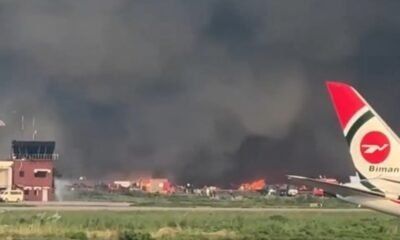WORLD
Top 5 crucial tips on Everest Base Camp Trek: Not your everyday advise
The best crucial tips on Everest Base Camp trek that no one told you.
Published
2 years agoon
By
Gems Sierra
The best crucial tips on Everest Base Camp trek that no one told you
By Karan Bhatta, Updated 15th May, Monday
The Everest Base Camp is Nepal’s crowning Jewel for trekking. But despite the ever-growing number of tourists here, they are often found bereft of ideas of how to trek better. Yes, there are the mountains, the cold, the solitude, and everything commercial. But what does it really take to make the best of your trek? What advice would you heed, and what crucial tips are there for trekkers?
After Hillary and Tenzing turned the improbable of climbing the tallest mountain in the world, i.e., Everest, into something scalable, the Everest Base Camp trek became popular. And it was only after the commercialization of this route by the opening of the airport and various shops and lodges around the Khumbu region that the Everest Base Camp trek flourished into a trekkers hub where tens of thousands of trekkers come each season.
And we’ve got to understand the history of the region, its unique culture, and the zeitgeist of the Khumbu region itself if we are to get hold of the crucial tips for trekking to the Everest Base Camp.

Some Thought-provoking facts about the Everest Base Camp Trek
- The Everest Base Camp also lies in Nepal’s northern neighbor: Tibet. The Base Camp there is accessible by vehicle as well, making it a popular choice for anyone not enmeshed in the rigors of trekking to the Everest Base Camp. The Bases Camp accessible from Nepal is known as the “Southern Base Camp,” while the one in Tibet is called the “Northern Base Camp.”
- When it was proposed that Syangboche airport be opened, the people (including air operators) who ran businesses in areas close to Lukla once protested against it, feeling that this would affect the businesses. This is because the Syangboche airport would cut down the number of trekking days by 2.
- There were times when Tibetans made it across the northern border to regions in Khumbu and established a sale of Tibetan products. These products were almost 3-5 times cheaper compared to Nepalese goods of the same quality.
- There is a glaring problem of the thinning reserves of snow and ice in the region of Everest Base Camp and the region upwards of it.
- If you’re trekking to the Everest Base Camp, you are likely to marvel at the pristine condition of the night sky where the stars, against a backdrop of an all-enveloping bluish void, twinkle marvelously.
With the aforementioned cool facts about the Everest Base Camp Trek, which might have shed some new perspective on the trek, let’s look at the tips that we hope you find useful while exploring the Khumbu Region.

Try Learning About the Environment of the Everest Base Camp and be responsible for it.
If you stayed in the Khumbu region for about a week and saw how people handled the waste that was being produced, you’d be staggered. All of the plastic, paper, scrap metals, etc., are taken in an open field and simply burned. Even in Khumjung Secondary School, which is supposed to be an institution of learning, you get a glimpse of this horrible practice of burning waste, which has been proven to have a lot of health effects.
Various types of waste in the Khumbu Region
So during the night time on Fridays or in 15 days’ time, you’d see the skies of certain areas of Khumbu become volcanic- not from a volcano but from the massive pile of rubble that is burned.
So we’d urge you to take this problem into consideration and refrain from bringing plastic, paper, etc., into the region under the guise of “dietary concerns.” We hope you learn about the “dietary practices” in the Khumbu region and consume “locally produced food,” which reduces the environmental strain. If you want to know what calorific values you get in the food that is typically served in the Everest Region, you can learn about it and know how to manage your food better whilst you’re there.
Getting Fitter to Cut Down on the Environmental Costs
Better yet, get through some rigorous practice to complete the Everest Base Camp Trek. That’ll work out wonders.
Being physically fit and preparing a lot will make you immune to problems related to acclimatization. And we know that acclimatization problems can lead to the necessity of helicopter rescue. And that, again, will lead to environmental issues related to aviation.
With the growing number of helicopters operating in the Everest region, there is bound to be some discomfort to the animal/ bird population of the region.

Reading through the prayer flags and stone inscriptions in the Everest Base Camp
If you’re well-versed in the Tibetan language, you can read the chants and mantras printed on the Everest Region’s prayer flags. Primarily, there are two types of prayer flags: the horizontal ones called “Lung-Ta,” which blaze across the high ends of temples and monasteries, and the “Darchog”- the vertical ones attached to poles.
These prayer flags’ meanings or dedication aren’t directed at a particular object or deity in veneration. They just float in emptiness- sometimes a beautiful notion that the messages in these flags float through the skies and spaces in between – in a serene, calm manner, blown across by the forces of nature, in ways we can’t describe: in the flow of the universe.
Some of the stone inscriptions have messages such as “Om Mani Padme Hung,” which, when recited, are believed to cultivate qualities such as compassion and equanimity. Others say the prayer refers to the fact that the universe is reflected in a pearl.
There is also something that is referred to as the “Four Immeasurables,” which can be inscribed in the stones and temple carvings (in Tibetan):
“ May all beings have happiness and its causes, (Love)
May all beings be freed from suffering and its causes; (Compassion)
May all beings constantly dwell in joy, transcending sorrow; (Joy)
May all beings dwell in equal love for those both close and distant. (Equanimity) “

Planning the trip to coincide your stay with festivals
There is a particular festival that is celebrated in the Khumbu region (and most notably in the Tengboche region) known as Mani Rimdu. This festival, which encompasses a wide range of ceremonialism, dance, and drama, goes on for more than a couple of weeks.
Besides the famed Tengboche monastery and monasteries in some off-beat places such as Thame and Chiwong, the date of the festival is set according to the Tibetan calendar.
Another important festival in the Khumbu region is the “Dumjee.”
If you plan your Everest Base Camp trek so that your trek coincides with these festivals, maybe you’ll get to immerse yourself greatly in the myths and legends of the Everest Base Camp.
Learning the most beautiful phrases in the Everest region
- “Tashi Delek” is one of the most wonderful expressions among the people in the Khumbu region. This roughly translates as “Auspiciousness and blessings be showered to this environment.
- “Sonam” is a name that is typical of boys and girls in the Sherpa community and carries the meaning of “Merit.” “Sog” expresses a wish. So “Sonam Sog” would be equivalent to saying “May Merit be there.”
- “Yeti” is the name of what is dubbed to be “an abominable snowman.” These apes, it is said, were like humans- only with reduced cognitive abilities. Sherpas of the Khumbu region share the myth that Yeti would imitate whatever humans did. So when humans wanted to get rid of the Yeti from the Khumbu community, they pretended to inflict “harakiri” upon themselves or staged stabbings of other people. The Yeti followed suit but with real knives and killed much of their own population.
- The word “Rinpoche,” which we often hear in the Tibetan language, often refers to as “oh! Precious one”. So “Guru Rinpoche” would translate as “my precious guru/ teacher.”
- When you’re offered a cup of tea/ coffee in the Khumbu region, they tend to refill it multiple times. Say if you’ve had enough of the refilling, you’d politely say, “Thank you. I have had enough”. But in the Khumbu region, people often say “Thug Che” – a word for compassion. Perhaps to indicate that the person was compassionate enough to grace the other with tea.

Examine the hyperbole of travel Companies’ articles.
There is an unhealthy practice of travel companies asking people to write blog posts on things they have never experienced. Say a high school student who has never been to the (Everest) Base Camp region of the country tends to write blog posts about these regions. This creates a scenario where people are engaged in false/mis/disinformation.
Sometimes you get to read things such as “You can trek to the Everest Region any season.” And with false advice like this, trekkers can get trapped in unchartered territories. It is one of the reasons why there has been an upsurge in the number of tourists who have lost their lives while trekking as the trekkers found themselves trapped in snow-laden, rain-deluged areas.
While theoretically, it is true that you can trek to the Everest Base Camp any season, the rainy season is particularly tough, even for locals, to trudge towards places such as Namche Bazaar. If your flight gets canceled and you’ve got to walk to Lukla instead of taking the flight, you’ll see the trekking trails are really treacherous – bordering on fatal.
So please be aware of the traps that travel companies in Nepal set you up on. Not all information they’ve written is valid. And often, the information they’ve posted on their websites are third-class writings of second-hand experiences lived first-hand by people who find it terribly difficult to convey their ideas well.

Conclusion
So be practical when traveling. Cultivate how to be international and learn about the religions, symbolism, myths, and bits of the language of the region to get immersed in the Everest region. Yes, the mountains will be sacred, wise, and calm and will stare at you with all their stillness, but there’s so much more to the Everest region than just the mountains. I hope these cues will be helpful if you decide to come here.
“Tashi Sog” is a Tibetan expression that translates as “May there be auspiciousness.”
Tashi Sog!!
Photo Credits:
Scott Goodwill
You may like
-


Massive Fire Erupts at Dhaka’s Hazrat Shahjalal International Airport — Flight Operations Suspended
-


Nepal Airlines’ Guangzhou Flight Postponed: Mismanagement or Diplomatic Delay
-


Boeing Regains FAA Self-Certification Rights, Airlines Eye New Connectivity Upgrades
-


Aviation News Update – 16th August 2025
-


Visitors’ Pass Banned at Tribhuvan International Airport
-


Air India London‑bound Flight AI2017 Aborts Takeoff in Delhi Due to Technical Glitch (July 31, 2025)
